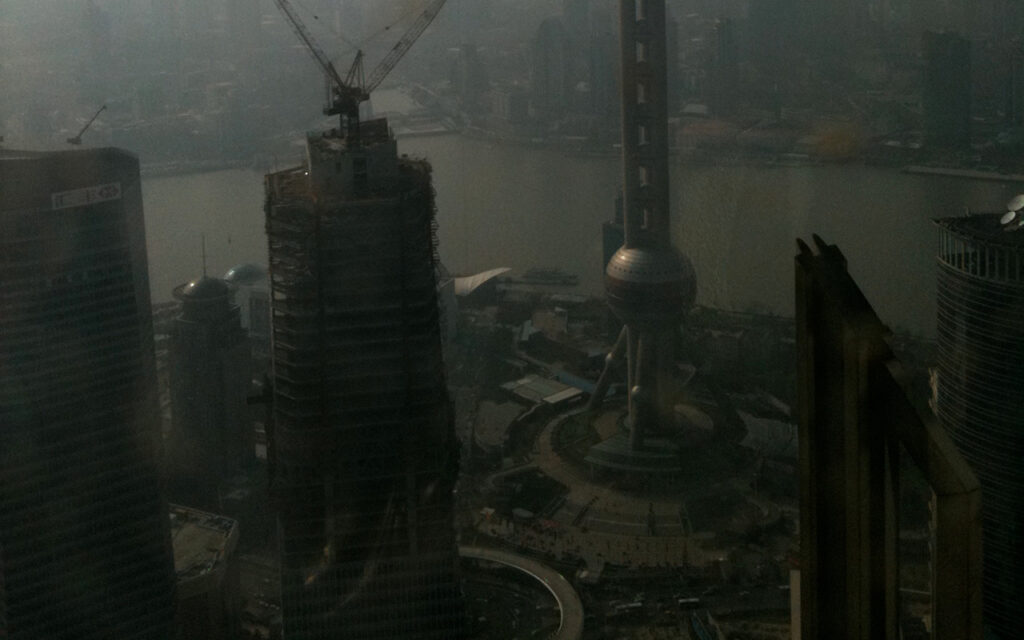
To spend eight-plus hours at Bahrain International Airport is to watch globalization play out in real time. The endless limbo of transit between cross-continental flights is interrupted by flows of international manpower. Herds of long-distance commuters move through the vast expanses of polished white concrete flooring and rows of grey modular seating. You watch as 200 guest workers from Bangladesh pass, dressed in lungis and polyester suits, on their way to Riyadh. Soon after, fifteen or so Saudi businessmen in traditional thawb shirts transit on their way to Shanghai. Later, another 200 guest workers flow through the airport with boxes and plastic bags, this time hurrying home to spend the holidays in Karachi. Now and then, you hear the laughter of twenty young English women in designer jeans, carrying monogrammed canvas bags, presumably on their way to some event.
Perhaps the flows of manpower for the global economy have become so apparent because of the trimming and speeding up that have made global logistics into a lean and cost-effective machine. Much of the sophisticated glamour connected with air travel in the late twentieth century is long gone. Today it is more associated with packed-out airports, queues for security checks and flight delays.
Fashion workers are parts of this machinery. The last few decades have increased the huge extent to which fashion travels – not just in terms of the number of garments and tons of textiles churned out of factories and lugged over the world to growing global markets, but also increasingly as the logistics that form and underpin the artistic and cultural aspects of fashion are dependent on global transportation. Fashion professionals perform diverse tasks such as trend-spotting, sourcing, development of materials and samples, working with ateliers and craftspeople who are located in hot spots over the globe from where they influence the colours, surfaces, cuts and shapes of fashions. The globalization of contemporary fashion is therefore no longer just a question of logistics but also of aesthetics.
Being attuned to this kind of manifestation of global market logistics may also come out of my personal experience as a fashion designer. My observations of commuters in Bahrain International Airport were made en route to Nepal, where I was trying to find ways to collaborate with small, cottage industry units that aim to improve social issues in the country. Exploring alternative ways to navigate a fashion system, seeking to include social enterprise, certainly creates awareness of one’s own role in the industry and of one’s personal characteristics. These include how professionals, like myself, who transit across time zones to operate in the global fashion industry, may be easily spotted by their branded loungewear, large cashmere shawls, outsized bags and iPhones that are permanently connected to the Instagram server.
For almost 50 years our routes have been etched increasingly onto the informal global fashion map: the first stop are the metropolitan hubs at which trends are spotted. Next are exhibition centres for sourcing, for fabric and yarn shows. The third stop is southeast Asia in order to set up production lines and manufacturing. And since high street fashion had largely merged with designer fashion by the turn of the last century, the global armada of designers and production managers have trodden much the same paths. Twice per year, the route is repeated: trend-spotting, sourcing, production.
I have observed this pattern forming over the years. Soon after leaving fashion school in the early 1980s I had a chance posting in Bangladesh, working with cottage industries to create an atelier collection from local silk. Until I came almost full circle with the cottage industry project in Nepal much later, I observed developments from several vantage points and perspectives. I worked with both small designer labels and global retailers in Stockholm and Paris. Later, I saw how the industry was changing while covering global fashion weeks and markets for magazines and newspapers and editing a trade journal. The bigger picture became more apparent while I was conducting studies for governmental agencies and international organizations, observing in 2005 how abolished restrictions in world trade created clear winners and losers on the global fashion market. As obstructions were removed to truly globalize fashion, there appeared to be a strong link to the designs and products that defined the era – logo-heavy leisurewear and globally advertised it-bags. It seemed that the logistics and aesthetics were highly connected and interdependent.
In that way, the tracks made by global commuters have become sharper and deeper with growing fashion output requiring larger amounts of raw materials, resulting in ever greater landfills. As industrial logic has been able to play out, the fashion industry has become successively streamlined and is currently all-encompassing. It is not only that ever more people globally are invited to participate in fashion culture due to rising incomes and the rise of middle classes in emerging markets: the transformation of the fashion industry has occurred parallel to, and at the same time as, a conversion of fashion content itself.
Extract from “Producing Garments, Manufacturing Fashion: On the Globalization of Industry and Disconnection with Craft.” Fashion Aesthetics and Ethics: Past and Present. Ed. Louise Wallenberg and Andrea Kollnitz London: Bloomsbury Visual Arts, 2023. 75–90. Photo Göran Sundberg
